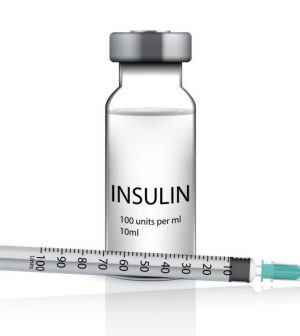- Skip Storing This Everyday Product in the Fridge Door
- Green Tea + B3 Pairing May Boost Brain Health
- Navigating Your Midlife Crisis: Embracing New Possibilities
- City Raccoons Showing Signs of Domestication
- Mapping the Exposome: Science Broadens Focus to Environmental Disease Triggers
- One Week Less on Social Media Linked to Better Mental Health
- Your Brain Changes in Stages as You Age, Study Finds
- Some Suicide Victims Show No Typical Warning Signs, Study Finds
- ByHeart Formula Faces Lawsuits After Babies Sickened With Botulism
- Switch to Vegan Diet Could Cut Your Greenhouse Gas Emissions in Half
Insulin May Not Need Refrigeration, Freeing Up Its Use in Poorer Nations

Researchers report that insulin can be stored at less-cold temperatures than previously known, potentially simplifying diabetes care for people in warmer regions that have fewer resources.
Researchers from Doctors Without Borders and the University of Geneva tested insulin storage in real conditions ranging from 77 to 98.6 degrees Fahrenheit for four weeks — the time it typically takes to use a vial.
They found that the stability of insulin stored under these conditions was the same as that of cold-stored insulin, with no impact on its effectiveness.
“These results can serve as a basis for changing diabetes management practices in low-resource settings, since patients won’t have to go to hospital every day for their insulin injections,” said study author Philippa Boulle, a non-communicable diseases adviser at Doctors Without Borders.
Boulle said this would have to go hand-in-hand with patient education, support and follow-up so people with diabetes can measure their blood sugar levels and inject the proper amount of insulin.
The researchers hope for a consensus statement focusing on at-home use of insulin in high-temperature settings when no refrigeration is available. They also hope it will be endorsed by the World Health Organization (WHO).
People with type 1 diabetes inject insulin to help sugar enter cells. The disease causes elevated blood sugar levels, which can cause coma, blindness, amputation and death if not managed.
Current pharmaceutical protocols call for patients to store insulin at 35.6 to 46.4 degrees F until opened and then at 77 degrees for four weeks.
In regions such as sub-Saharan Africa, where not every household has a refrigerator, people with diabetes must go to the hospital for injections several times a day. That creates a travel burden, limits their ability to work and increases discrimination.
“This is obviously an issue in refugee camps in temperatures hotter than this, where families don’t have refrigerators,” Boulle said in a university news release.
A Doctors Without Borders team that visited a refugee camp in northern Kenya found that home temperatures fluctuated between 77 degrees F at night and 98.6 degrees F during the day.
Researchers reproduced these conditions in a lab to test insulin storage over four-week periods.
Insulin stored at fluctuating temperatures lost no more than 1% in potency — the same as insulin kept in cold storage, University of Geneva researchers found.
“The regulation on pharmaceutical preparations allow a loss of up to 5%, so we are well below that,” said co-author Leonardo Scapozza, a professor of pharmaceutical biochemistry.
He and his colleagues also found that insulin activity was fully maintained. “The insulin was perfectly usable,” Scapozza said in the release.
The findings were published Feb. 3 in the journal PLOS ONE.
More information
For information on managing diabetes, visit the American Diabetes Association.
SOURCE: University of Geneva, news release, Feb. 3, 2021
Source: HealthDay
Copyright © 2025 HealthDay. All rights reserved.










